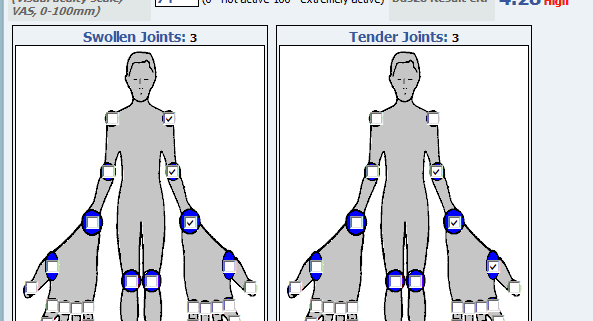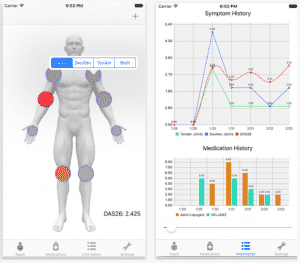One of the two digital health companies in Boomtown’s current health-tech class, cliexa develops mobile applications that assist users in managing their chronic diseases.
Rheumatoid arthritis (RA) is a chronic inflammatory disease that may impair daily functioning and quality of life due to pain, swelling and stiffness. The disease has an unpredictable course and the main treatment goal is to suppress disease activity in order to prevent joint damage and to improve daily living. Treatment of RA mainly includes disease modifying anti-rheumatoid drugs including biologicals. Both international and national treatment guidelines recommended assessing the disease activity using measures such as DAS28, and doing regular follow up assessments, in which the level of activity dictates the frequency of monitoring. Frequent and regular assessments, however, may not be possible in a clinical practice because of a busy daily schedule.
Healthcare data suggest that Patient Reported Outcomes (PROs) have certain significance for routine clinical care. Following are the questions that we will be discussing here: What is the validity of patient self-report outcomes to guide a treat-to-target strategy in clinical trials and usual clinical care of rheumatoid arthritis? Which measures to use? How could physicians (Rheumatologists) use these measures in a daily clinical practice? Challenges involved, and why DAS28? How could patients contribute to their own treatment?
What is the validity of patient self-report outcomes in clinical practice?
It seems attractive to assess disease activity from patient’s perspective using validated patient reported outcomes (PROs) as an alternative or as an addition to laborious frequent joint assessments. There is evidence concerning PROs in clinical care in documenting low disease activity and remission, including a meta-analysis of studies that document the value of using PROs to implement ‘treat-to-target.’ PROs are well established by groups of experts from the Outcome Measures in Rheumatoid Arthritis Clinical Trials –working group (Felson et al , 1993). Patient global health (pGH) a PRO element is included as a recommendation in the 2010 (ACR-EULAR guideline that proposed tighter definitions for clinical remission in clinical trials, and is now also established for clinical practice (Smolen et al, 2013).
Which measures to use?
Of the 63 currently available RA disease activity measurement tools, the data may be filtered down to 6 recommended measures: the CDAI (clinical disease activity index), DAS28 (ESR and CRP; disease activity score with 28 joint counts) PAS (patient activity scales), PAS-II, RAPID-3 (routine assessment of patient index data), and SDAI (simplified disease activity index). All 6 measures produce a single consistent index and have defined ranges for indicating low, moderate, or high disease activity or clinical remission. Studies demonstrated that by applying these tools systemically in clinical practice, physicians would be able to treat to target and effectively implement the American College of Rheumatology recommendations for the treatment of RA (J. Anderson et al, 2012).
How could physicians (Rheumatologists) use these measures in a daily clinical practice? Challenges involved, and why DAS28?
Realizing the heterogeneity of settings in which health care is delivered to patients with RA in the US, there are selected measures that offer a full range of data collection options. Some are purely patient-reported (PAS, PAS-II, and RAPID3), some need physician assessment (CDAI), and some need physician and laboratory acute phase reactants (SDAI and DAS28). While most of these measures are considered as possible options, purely patient-reported measures may lack formal assessments. Therefore, patient-reported measures must be complemented by a careful joint examination, and do not prevent performance of a formal joint count or any other measure by a treating physician. Meanwhile, DAS28 calculations provide use of a continuous measure with absolute laboratory values and formal physician-assessment in daily clinical practice and clinical trials. Therefore DAS28 has been shown to a useful instrument to monitor disease activity in to titrate treatment with biologicals (Fransen et al, 2005). However, frequent collection of patient data and calculations are challenging in a busy rheumatology practice. There are indications that the DAS28 is not measured frequently enough in standard rheumatology care. Thus, daily, regular, patient self-report joint assessments may provide a useful, cost-effective method to complement physician’s role and implement treat-to-target in patients with RA.
How can you -as a patient- contribute to your own RA- treatment?
Collaborative Network 4 Clinical Excellence (CN4CE) has recently launched an application, cliexa-RA that is based on DAS28 score calculations with erythrocyte sedimentation rate (ESR). Cliexa-RA is available for iOS devices in the Apple store. This, so far unique, application is designed to combine patient-reported measures, with laboratory (ESR values) and provides an essential tool for the physician to review quickly and monitor disease activity, and make a medication titration, even within a busy schedule. This application is designed to collect patient self-reported joint symptom data and medications, daily and frequently, and calculates DAS28 scores automatically by combining the other variables involved in DAS28 scoring system (such as ESR). Physicians act to complement patient’s role by reviewing and confirming the data. Thus, cliexa-RA provides disease activity monitoring tool based on DAS28 scoring system and data on the medication history over a time period. cliexa-RA not only increase awareness, and encourages patients to involve in their own treatment, but also provides an effective support tool for the physicians’ office to increase treatment outcomes and implement treat-to-target in patients with RA.
Esra Nutku-Bilir MD, PhD
Co-Founder, Scientific Advisor
Post Doctoral Award recipient from American Rheumatoid Arthritis Foundation
cliexa™ Launched Its first Rheumatoid Arthritis Disease Activity Tracking Mobile Application, cliexa-RA
Chronic Care Analytics, Chronic Care Management, Chronic Disease Activity, Clinician Experience, Digital Health, Mobile Health, News, Patient Engagement, Patient Reported Outcomes, Population Health, Press Release, Preventive Care, Responsive Care, Value-based CareFeb. 11, 2016 – Collaborative Network 4 Clinical Excellence, LLC (CN4CE) has just launched their first mobile chronic disease tracking application, cliexa-RA. cliexa-RA is available for iOS devices in the App Store. It tracks medications, symptoms and disease activity for Rheumatoid Arthritis. The Clinical Excellence Algorithms concept, cliexa™, is the healthcare technology product line for CN4CE which is built on published and recognized scientific quantitative models that translate chronic disease activity into a scoring model.
The Genesis of cliexa™ originated with the idea of applying mobile technology to help optimize chronic disease care. cliexaTM utilizes mobile applications to help patients more accurately track key disease activity indicators used by their physicians to make decisions about their care plan. While CN4CE focuses on Clinical Excellence Networks (CEN) and Disease Management Algorithms/Protocols, cliexa™ interfaces with end users, enabling patients to track daily chronic disease symptoms as well as medications.
cliexa™ is a powerful communication layer for end users to sync with physicians, clinics and other healthcare providers for disease activity tracking and reporting. It also integrates well with cliexa™ web protocols to update Disease Protocols, managed by Medical Directors (CEN) along with the physicians who are experts in their respective specialties.
CN4CE’s Lance Goudzwaard said, “It is hard to remember your RA symptoms and accurately communicate it to physicians during visits.” Dr. Robert Spencer has been integral in developing cliexa-RA, a tool which allows RA patients to calculate and follow their disease activity using an accepted disease activity measure called the DAS-28. Dr. Spencer stated that, “In today’s demanding medical environment physicians have limited time to gather relevant data, much less calculate an activity index. With an easily used technology application, patients can be instrumental in helping their doctors determine their disease activity, which, in turn, can lead to better informed treatment decisions.” With cliexa-RA we are offering a free mobile application to achieve this goal. CN4CE Co-Founder and the Scientific Director Dr. Esra Nutku-Bilir said, “cliexa-RA is one step forward in healthcare. The goal has been to design a tool to provide a service based on a need in healthcare… cliexa-RA is designed to gather real life data, which may provide a service tool for patients, physicians, health insurance companies, pharmaceutical companies, with an immense potential to reach out to every aspect of healthcare, today and in the future”.
Bahri Bilir MD FACP FAASLD, could not hide his excitement: “I found this app to be a very important step in realizing the vision of CN4CE, to provide tools to achieve best outcomes in complex chronic illnesses. The simplicity of this app, will allow patients with RA, without anybody’s help, utilize a well accepted and validated scientific tool, to continuously assess and monitor the activity of their illness. I believe that it will improve their adherence to the medications, when they are in remission. In the possibility of a flare, they will be able to see the warning signs, and reach out to their physicians earlier, before they develop deformities or costly ER visits and hospitalizations.”
CN4CE Co-Founder and CEO Mehmet Kazgan added, “Our ultimate vision is to adapt this modular system to other chronic diseases where certain data or clinical indices have been shown to have evidence-based utility in disease and treatment monitoring.”
About CN4CE
CN4CE staff consists of executive healthcare professionals, physicians, scientists and technologists. CN4CE was founded originally in 2011 focusing on Dr. Bahri Bilir’s evidence based disease algorithms concept which has a patent pending status.



